McDonnell Douglas MD-83
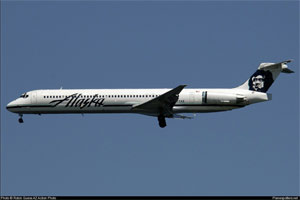
Copyright Robin Guess - used with permission
Alaska Airlines Flight 261, N963AS
Anacapa Island, California
January 31, 2000
On January 31, 2000, about 1621 Pacific standard time, Alaska Airlines Flight 261, a McDonnell Douglas MD-83, N963AS, crashed into the Pacific Ocean about 2.7 miles north of Anacapa Island, California. All 88 people on board were killed and the airplane was destroyed on impact. Flight 261 was a scheduled international passenger flight from Lic Gustavo Diaz Ordaz International Airport (PVR), Puerto Vallarta, Mexico, to Seattle-Tacoma International Airport, Seattle, Washington, with an intermediate stop planned at San Francisco International Airport, San Francisco, California.
The National Transportation Safety Board (NTSB) determined that the probable cause of this accident was a loss of airplane pitch control resulting from the in-flight failure of the horizontal stabilizer trim system jackscrew assembly's Acme nut threads. The thread failure was caused by excessive wear resulting from Alaska Airline's insufficient lubrication of the jackscrew assembly.
Accident Overview
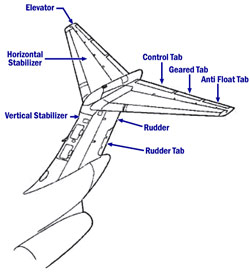
vertical stabilizer and control systems
View Larger
Alaska Airlines Flight 261 with two pilots, three cabin crew, and 83 passengers departed Puerto Vallarta (PVR), Mexico to Seattle, Washington with a scheduled stop in San Francisco, California.
Visual meteorological conditions prevailed for the flight that operated under an instrument flight rules flight plan.
The airplane was functioning normally during the initial phase of flight, but the horizontal stabilizer stopped responding to autopilot and pilot commands after the airplane passed through 23,400 feet.
The pilots recognized the longitudinal trim system was not functioning but could not determine why.
The longitudinal trim system allows the pilot to stabilize the airplane with zero control forces or allows the autopilot to control pitch. For the MD-83, the system consists of a single jackscrew and gimbal nut, located near the top of the vertical stabilizer, with primary and alternate motors that drive the jackscrew assembly. The jackscrew nut (Acme nut) is fixed, and rotation of the jackscrew through the Acme nut moves the horizontal stabilizer to trim the airplane. The Acme nut is intended as the "wear point" in the system and requires regular lubrication and inspection.
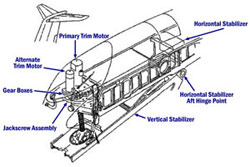
trim actuator installation
View Larger
The jackscrew is retained at the lower end by an end cap and at the upper end by a fixed stop.
The airplane takeoff (TO) weight was 136,515 pounds, well below TO and climb limits. The airplane maximum landing weight was 130,000 pounds so the airplane would have been required to remain in flight for 45 minutes in order to burn enough fuel to reach the max landing weight.
The flight crew did not elect to return to PVR. Neither the Alaska Airlines MD-80 Quick Reference Handbook Stabilizer Inoperative nor the company Runaway Stabilizer Emergency Checklist required landing at the nearest suitable airport.
The flight crew manually flew the airplane and contacted Alaska Airlines dispatch and maintenance control in San Francisco when they got close to the U. S. border, approximately two hours after departure.
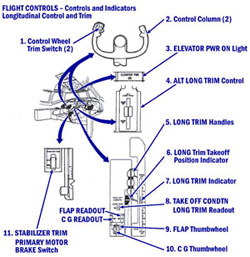
View Larger
At altitude and higher cruise speed, manually flying the airplane was not difficult for the crew.
The crew discussed the malfunctioning trim system and current and expected weather at Los Angeles (LAX) and San Francisco (SFO) with Alaska's dispatch and maintenance. Although the crew elected not to return to Puerto Vallarta, they decided to land at LAX rather than continue to SFO. The weather conditions at SFO, prevailing crosswinds, the increased landing speed required, and over flying a suitable airport (i.e., LAX) may have influenced their decision.
After flying manually for two hours, the crew tried to use the autopilot several times and it disengaged each time.
The flight crew was troubleshooting the trim system by using the trim handles and control wheel trim switches while in contact with the dispatch and maintenance personnel. The Alaska Airlines MD-80 Stabilizer Inoperative checklist states, "do not use the autopilot" if the trim systems are inoperative.
While the flight crew was troubleshooting the system, the primary trim motor moved the jackscrew and freed the jammed Acme nut, allowing the horizontal stabilizer to move leading edge up until it reached the lower mechanical stop, initiating a dive from the cruise altitude of 31,050 feet.
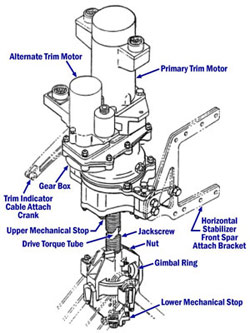
View Larger
The crew made control inputs to bring the nose up, deployed the speed brakes to retard the rapidly increasing airspeed, and recovered from the dive at approximately 24,000 feet.
After the flight crew recovered from the initial dive, the crew deployed the slats and flaps to slow the airplane in preparation for an emergency landing at LAX; the airplane remained stable and controllable.
The slats and flaps were later retracted, and the airspeed increased. The captain then ordered redeployment of the slats and flaps. The Cockpit Voice Recorder (CVR) recorded a discernible noise; the airplane rapidly pitched nose down in the final dive and crashed into the ocean.
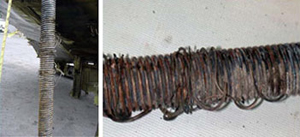
showing damaged threads
View Larger Images
Radar detected several small primary returns consistent with parts of the vertical stabilizer being torn from the airplane.
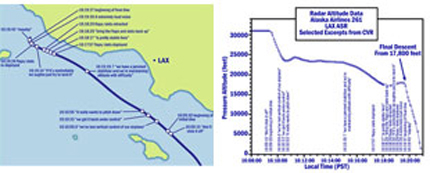
View Larger Images
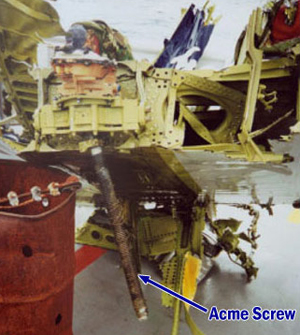
with jackscrew, as recovered from the ocean
See NTSB Horizontal Trim System Description and Sequence Failure Animation.
See Alaska 261 Jackscrew Flash Animation.
See Alaska 261 3D flight path Flash Animation.
After the accident, severely worn and sheared remnants of the Acme nut threads were recovered wrapped around the Acme screw. Approximately 90 percent of the thread thickness had worn away before the remainder of the threads sheared off.
When the crew operated the trim system, the jam was freed causing the initial dive. The Acme screw did not completely separate during the initial dive. The pilots knew the longitudinal trim system was jammed but did not know why. The worn threads of the Acme nut had been sheared off and jammed the Acme screw. The redeployment of the flaps and slats resulted in higher aerodynamic loads on the tail surfaces and caused the jackscrew and Acme nut to completely separate, and the final dive.
Accident Memorial

Memorial to the victims of Alaska Flight 261 located at Port Hueneme, California. The 20-foot-long sundial will cast a shadow on the memorial plaque at 4:22 PM each January 31.
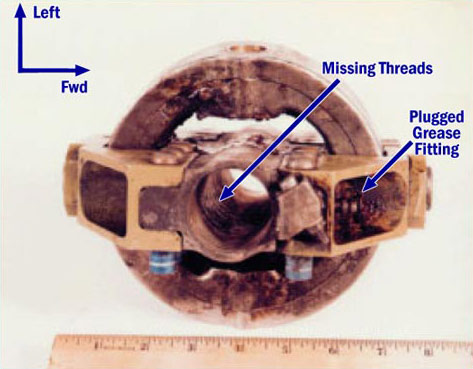
View complete text of the National Transportation Safety Board's Aircraft Accident Report which includes Accident Board Findings.
The safety board determined the probable cause of the accident was a loss of airplane pitch control resulting from in-flight failure of the horizontal stabilizer trim system jackscrew assembly's Acme nut threads. The thread failure was caused by excessive wear resulting from Alaska Airlines' insufficient lubrication of the jackscrew assembly.
While not specifically mentioned in the NTSB findings, the Acme nut grease fitting passage, which allows the grease to reach the jackscrew and Acme nut threads, was found plugged with dry residue.
The NTSB concluded that two major factors contributed to the accident: 1) Alaska Airlines' extended lubrication interval and the Federal Aviation Administration's (FAA) approval of that extension, which increased the likelihood that a missed or inadequate lubrication would result in excessive wear of the Acme nut threads, and 2) Alaska Airlines' extended end play check interval and the FAA's approval of that extension, which allowed the excessive wear of the Acme nut threads to progress to failure without the opportunity for detection. Also contributing to the accident was the absence of a fail-safe mechanism on the MD-83 horizontal stabilizer jackscrew trim system to prevent the catastrophic effects of total Acme nut thread loss. The dual-thread design of the Acme screw nut does not provide redundancy with respect to wear. The design of the jackscrew assembly did not account for the loss of the Acme nut threads as a catastrophic single-point failure mode.
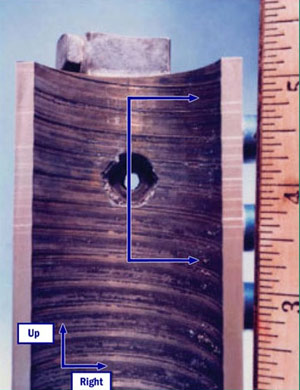
The NTSB viewed the decision not to return to Puerto Vallarta as understandable given that there is no requirement in the Airplane Flight Manual (AFM) to land at the nearest suitable airport following a jammed or malfunctioning horizontal stabilizer. The crew's decision to land at LAX was considered appropriate.
However, the flight crew's use of the autopilot while the horizontal stabilizer was jammed was not appropriate. The crew should not have tried to troubleshoot the system by using the autopilot and trim motors. Once a stable airplane-landing configuration was obtained, landing at LAX should have followed immediately.
View complete text of the National Transportation Safety Board's Aircraft Accident Report which includes Accident Board Recommendations.
The NTSB issued 16 safety recommendations with their final report and eight recommendations prior to the final report.
The subject areas covered that were design related include:
- Pilot actions on the use of procedures not included in the checklist or AFM with inoperative or malfunctioning control systems.
- Revise and mandate the maintenance procedures for greasing the jackscrew assembly.
- Increase the size of the access panel to accomplish the lubrication procedures.
- Evaluate maintenance tasks that could affect critical aircraft components to assure the original design assumptions are taken into account and are supported by technical data.
- Require Aircraft Certification Office concurrence on changes to maintenance tasks on critical systems before the PMI approves.
- Establish end play check intervals based on real data which account for wear rate.
- If practicable, require a fail-safe mechanism to prevent catastrophic effects of total failure of the Acme nut threads on DC-9, MD-80/90, and B-717 airplanes.
- Modify certification regulations, policies, and procedures so new horizontal stabilizer trim systems are not certified if they have a single-point catastrophic failure mode.
- Review and revise certification regulations/guidance to ensure wear-related failures are addressed, to the maximum extent possible, so that they will not be catastrophic.
The subject areas that were operationally related include:
- Surveillance of the operators.
- Lubrication inspection and documentation.
- Jackscrew overhaul capability, documentation, and equipment.
- Require operators to measure and record on-airplane end-play measurements whenever a jackscrew is replaced.
The eight recommendations issued prior to the final report included:
- Require Boeing to revise the lubrication and end-play check procedures for the horizontal stabilizer trim system for DC-9, MD-80/90, and B-717 airplanes.
- Require maintenance training for lubrication and end-play check.
- Require approval of changes to lubrication procedures.
- Provide notification to operators on use of inappropriate greases.
- Survey operators on intermix of greases.
- Convene an industry conference on greases.
While the structural requirements of 14 CFR 25 are generally applicable to the design and integrity of the MD-80 series airplane, regulations specific to the flight control system are:
14 CFR 25.395 - Control System
14 CFR 25.675 - Stops
14 CFR 25.677 - Trim Systems
It is a normal practice within the industry for airlines to modify maintenance and inspection intervals for airplanes and components to more closely align with airline operational needs. Alaska Airlines had gained approval to extend maintenance and inspection intervals on the horizontal stabilizer trim assembly. While this was not considered unusual, in this case it resulted in a jackscrew assembly on the accident airplane that was essentially unlubricated. A plugged grease fitting that was not discovered during routine inspection, lubrication of the jackscrew, and extended times between inspections allowed the jackscrew to wear beyond service limits without discovery.
Inadequate lubrication resulted in failure of the horizontal stabilizer jackscrew assembly Acme nut threads.
Undetected, plugged grease fitting passage.
Some of the key design and safety assumptions that played a role in this accident are listed below.
- The jackscrew assembly would function as designed with proper lubrication. The Acme nut grease fitting would perform as designed and not be clogged/plugged. The Acme nut threads would not shear/fail in flight due to its double thread fail-safe design.
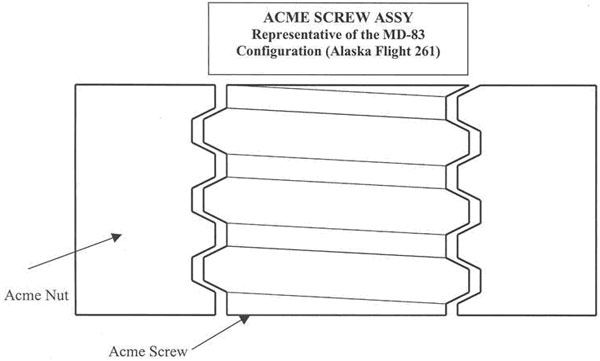
- The wear rate of the Acme nut thread was linear. (Assuming that the appropriate lubrication occurs at proper intervals).
- Worn jackscrew assemblies would be identified by end-play maintenance checks and removed from service prior to significant structural deterioration. Therefore, a completely worn Acme screw was not considered in the safety analysis as a failure mode. Also, failure analysis assumes that a jackscrew would be jammed in any Acme screw mechanical failure mode.
- The flight crew would follow airplane flight manual (AFM) procedures for a jammed or malfunctioning horizontal stabilizer and not continue to troubleshoot the system to free the jam or correct a malfunctioning system.
- Horizontal stabilizer runaway limits and airplane testing were based on autopilot/motor failures, not Acme nut thread failure.
Analysis of previous incident data reveals three cases and one accident related to Acme nut/jackscrew problems:
Failure to adequately maintain the pitch trim system resulted in failure of the Acme nut threads, a jammed jackscrew, and the eventual loss of pitch control.
- On February 25, 1964, an Eastern Airlines DC-8 crashed near New Orleans, La. The cause of the crash was determined to have been related to abnormal trim system operation during heavy turbulence.
- In 1969, a DC-8, with a similar jackscrew design, had an incident of a jammed stabilizer due to worn jackscrew threads, lack of lubrication, and corrosion.
- In 1995 an MD-11 had excessive wear of the Acme nut due to improper screw thread surface finish. AD 98-16-01 was issued that stated, "If not corrected, this condition, in conjunction with a failure of the opposite jackscrew assembly, could result in a free horizontal stabilizer that would cause the loss of airplane pitch control."
- In 1997, a DC-8 incident occurred where the Acme nut threads were completely stripped.
While the DC-8 and MD-11 have a dual jackscrew design versus the single jackscrew design of the DC-9/MD-80, the criticality of a jackscrew nut failure was known. There was no special emphasis on the need for maintenance of the system because of the criticality.
The FAA Commercial Airplane Certification Process Study (CPS), issued in March 2002, was a direct result of this accident and the TWA B-747 accident.
The report focused on numerous process categories, including human factors in airplane design, operation and maintenance, flight critical systems and structures, safety data management, maintenance/operations coordination, major repair and modification, and safety oversight.
The CPS findings and observations directly relate to all lessons learned from this accident. To view the CPS report, click here. The findings are contained in Appendix B, beginning on page 102 of the CPS report.
One airworthiness directive was issued as a result of this accident, AD 2000-15-15, which superseded AD 2000-03051
Airplane Life Cycle:
- Operational
- Design / Manufacturing
Accident Threat Categories:
- Structural Failure
- Lack of System Isolation / Segregation
Groupings:
- N/A
Accident Common Themes:
- Organizational Lapses
- Human Error
- Flawed Assumptions
Organizational Lapses
Alaska Airlines had extended the recommended maintenance and inspection intervals of the jackscrew assembly, resulting in it becoming unlubricated. A plugged grease fitting and inspection intervals that were beyond those recommended by the airplane manufacturer allowed the condition of the jackscrew to deteriorate to a sufficiently worn state that it failed and resulted in a loss of control of the airplane.
Human Error
The flight crew underestimated the severity of the threat to the airplane. The crew did not recognize the deteriorating flight conditions until it was too late. They spent approximately two hours trouble shooting prior to contacting the airline's dispatch and maintenance control facilities to discuss a jammed horizontal stabilizer and a possible diversion to Los Angeles International Airport
Flawed Assumptions
It was assumed that the horizontal trim system was sufficiently redundant that a failure of a single thread path would not interfere with the operation of the jackscrew or trim system. Ultimately, this assumption was flawed, as a single failure resulted in the structural failure of the horizontal stabilizer.
Certain designs have proven to be less vulnerable to wear and wear-related failures. Ballscrew thread configurations have shown to be more resistant to failures. Many current transport airplanes designs use ballscrew type assemblies for stabilizer trim.
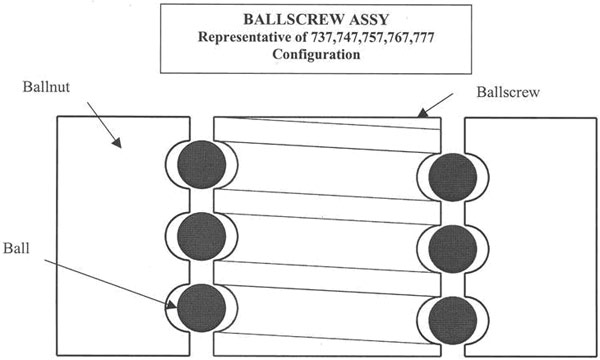
Eastern Airlines Douglas DC-8, New Orleans, Louisiana, February 25, 1964
Eastern Air Lines, Inc., Flight 304, a DC-8, N8607, crashed in Lake Pontchatrain, Louisiana, approximately 19 miles northeast of the New Orleans International Airport, at approximately 0205 CST, February 25, 1964. All 51 passengers and the crew of seven were fatally injured.
The flight, scheduled from Mexico City to New York City, with several intermediate stops, had just departed New Orleans at 0200. Three minutes later the captain acknowledged a request to change radio frequencies, but no further communications were received from the flight. At 0205-40 the radar target associated with Flight 304 had disappeared from the scopes of both the radar controllers who were observing the flight. Moderate to severe turbulence existed in the area at the time of the accident.
The Civil Aeronautics Board determined the probable cause of this accident was the degradation of aircraft stability characteristics in turbulence because of abnormal longitudinal trim component positions.
Technical Related Lessons
Single point failure of any critical structure or system should be avoided through design, whenever practical. Where single point failures are unavoidable, robust safety provisions must be in place, including inspection and maintenance intervals, which will preclude the catastrophic failure. (Threat Category: Lack of System Isolation/Segregation)
- The jackscrew assembly had functional redundancy; in that it was designed with two independent sets of threads. However, a single failure of the Acme nut threads allowed all the threads in the assembly to be stripped (fail), which freed the jackscrew from the assembly, and resulted in unrestricted motion of the horizontal stabilizer.
Common Theme Related Lessons
Safety strategies that are dependent on multiple load paths should ensure that the load paths are adequately isolated. (Common Theme: Flawed Assumptions)
- The horizontal stabilizer jackscrew and nut assembly were designed with two sets of helical threads, intended to operate independently. Both sets of threads were load bearing and supported the flight loads imposed on the horizontal stabilizer. The design intent of the dual threads was to provide redundancy should a single thread path fail. Appropriate isolation of the threads would have allowed the failure of one set of threads without threatening the integrity of the other set of threads. In this accident, the failure of a single thread path resulted in the failure of both paths, resulting in failure of the jackscrew, and the accident.
Deviation from flight crew procedures can have catastrophic results. (Common Theme: Human Error)
- The Alaska Airlines checklist procedure associated with the jammed horizontal stabilizer prohibited engagement, or use, of the autopilot. The flight crew, while troubleshooting the jammed stabilizer repeatedly attempted to engage the autopilot. The autopilot would momentarily engage, then disconnect. The repeated momentary engagement of the autopilot may have contributed to the thread failures in the acme nut, allowing the jackscrew to be unrestrained in its movement, resulting in the loss of control.
Certain key maintenance tasks should be identified and emphasized in a manner that ensures required tasks are consistently and correctly accomplished. (Common Theme: Organizational Lapses)
- The manufacturer intended that the stabilizer jackscrew receive required regular and consistent lubrication to avoid excessive, accelerated wear. Inadequate lubrication, either by extended maintenance intervals, or improper task performance, caused instances of under lubricated jackscrew assemblies, and in this case, total failure of the jackscrew assembly.